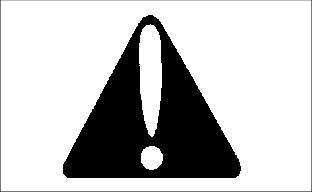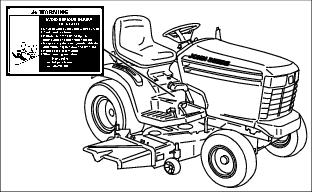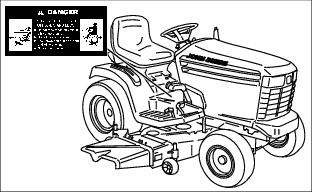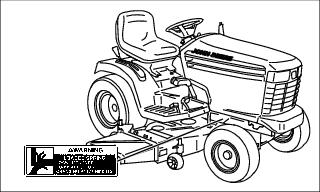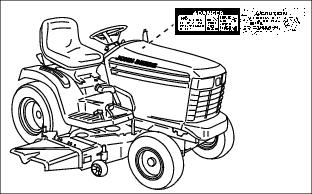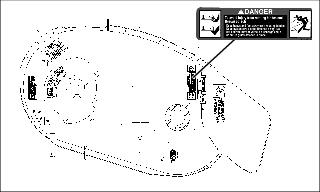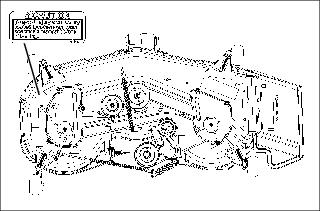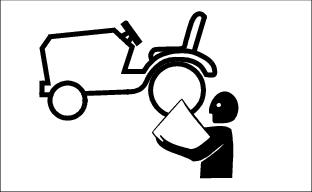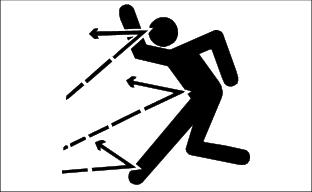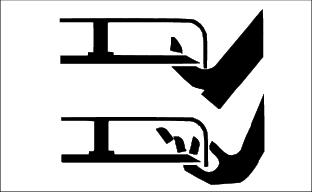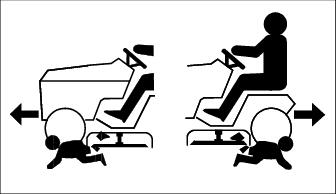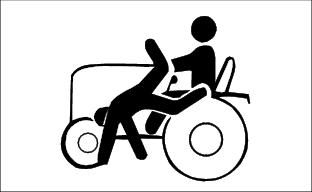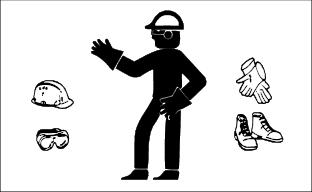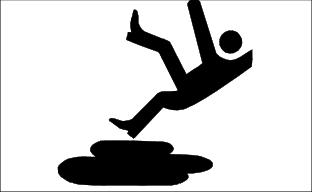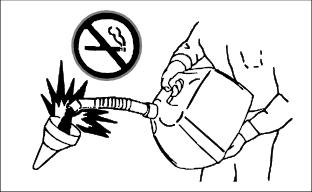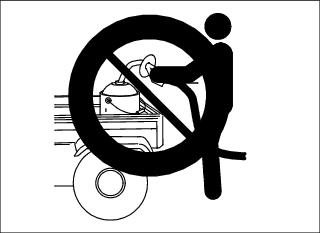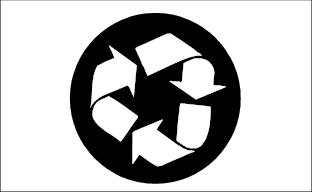Introduction
Product Identification
Safety
Understanding The Machine Safety Labels
WARNING: AVOID SERIOUS INJURY OR DEATH
DANGER: ROTATING BLADES CUT OFF ARMS AND LEGS
DANGER: ROTATING BLADE-THROWN OBJECTS
Emission Control System Certification Label (Small Off-Road Gas Engines)
Emission Compliance Period (Small Off-Road Gas Engines)
Driving Safely on Public Roads
Handling Waste Product and Chemicals
Operating
Replacement Parts
Service Intervals
Service Lubrication
Service Engine
Service Transmission
Service Mower
Service Electrical
Service Miscellaneous
Troubleshooting
Storage
Assembly
Specifications
Warranty
John Deere Quality Statement
Service Record

Safety
Understanding The Machine Safety Labels
The machine safety labels shown in this section are placed in important areas on your machine to draw attention to potential safety hazards.
On your machine safety labels, the words DANGER, WARNING, and CAUTION are used with this safety-alert symbol. DANGER identifies the most serious hazards.
The operator's manual also explains any potential safety hazards whenever necessary in special safety messages that are identified with the word, CAUTION, and the safety-alert symbol.
WARNING: AVOID SERIOUS INJURY OR DEATH
· Drive up and down slopes, not across
· If machine stops going uphill, stop blade and back down slowly
· Keep safety devices (guards, shields, and switches) in place and working
DANGER: ROTATING BLADES CUT OFF ARMS AND LEGS
· Do not mow when children or others are around
· Look down and behind before and while backing
· Never carry children even with blades off
WARNING: LOADED SPRING
Picture Note: Label appears at both sides of machine.
· Lock lift lever forward before changing attachments.
DANGER: CAUTION- POISON
Picture Note: Label appears on battery.
· Shield eyes, explosive gases can cause blindness or injury.
· Sulfuric acid can cause blindness or severe burns.
· Flush eyes immediately with water. Get medical help fast.
· Keep out of reach of children.
· Keep vent caps tight and level.
DANGER
Picture Note: Label appears on 42C mower only.
To avoid injury from rotating blades and thrown objects:
· Keep hands and feet away from rotating blades.
· Keep bystanders a safe distance away.
· Do not operate mower without discharge chute or entire grass catcher in place.
DANGER: ROTATING BLADE-THROWN OBJECTS
Picture Note: Label appears as shown on 48C and 54C. Label appears on discharge chute only on 42C.
· Do not put hands or feet under or into mower when engine is running.
· Before mowing, clear area of objects that may be thrown by blade.
· Do not operate mower without discharge chute or entire grass catcher in place.
DANGER: ROTATING BLADE
Picture Note: Label appears on all mowers.
· Do not put hands or feet under or into mower when engine is running
CAUTION
Picture Note: Label appears on 48C and 54C mowers only.
To avoid injury from spring loaded tension arm, read operator's manual before releasing.
Emission Control System Certification Label (Small Off-Road Gas Engines)
NOTE: Tampering with emission controls and components by unauthorized personnel may result in severe fines or penalties. Emission controls and components can only be adjusted by EPA and/or CARB authorized service centers. Contact your John Deere Commercial and Consumer Equipment Retailer concerning emission controls and component questions.
The presence of an emissions label signifies that the engine has been certified with the United States Environmental Protection Agency (EPA) and/or California Air Resources Board (CARB).
The emissions warranty applies only to those engines marketed by John Deere that have been certified by the EPA and/or CARB; and used in the United States and Canada in off-road mobile equipment.
Emission Compliance Period (Small Off-Road Gas Engines)
If your engine has the emission compliance category listed on the emission control system certification or air index label, this indicates the number of operating hours for which the engine has been certified to meet EPA and/or CARB emission requirements. The following table provides the engine compliance period in hours associated with the category found on the certification label.
Certification
Your mower has been certified by an independent laboratory for compliance with American National Standard B-71.1, "Safety Specifications" for Power Lawn Mowers, Lawn and Garden Tractors, and Lawn Tractors.
Operating Safely
· Read, understand and follow all instructions in the manual, on the machine and on the safety video before starting.
· Only allow responsible adults, who are familiar with the instructions to operate the machine.
· Inspect machine before you operate. Be sure hardware is tight. Repair or replace damaged, badly worn, or missing parts. Be sure guards and shields are in good condition and fastened in place. Make any necessary adjustments before you operate.
· Do not operate mower without discharge chute or entire grass catcher in place.
· Check brake action before you operate. Adjust or service brakes as necessary.
· Stop machine if anyone enters the area.
· If you hit an object, stop the machine and inspect it. Make repairs before you operate. Keep machine and attachments properly maintained and in good working order.
· Be aware of the mower discharge direction and make sure that no one is in the path of the discharge direction.
· Do not leave machine unattended when it is running.
· Only operate during daylight or with good artificial light.
· Be careful of traffic when operating near or crossing roadways.
· Do not wear radio or music headphones while operating the machine. Safe operation requires your full attention.
· Older adults are involved in a large percentage of riding mower accidents involving injury. These operators should evaluate their ability to operate a mower safely enough to protect the operator and others from serious injury.
Checking Mowing Area
· Clear mowing area of objects that might be thrown. Keep people and pets out of mowing area.
· Study mowing area. Set up a safe mowing pattern. Do not mow where traction or stability is doubtful.
· Test drive area with mower lowered but not running. Slow down when you travel over rough ground.
Parking Safely
1. Stop machine on a level surface, not on a slope.
3. Lower attachments to the ground.
7. Wait for engine and all moving parts to stop before you leave the operator's seat.
8. Close fuel shut-off valve, if your machine is equipped.
Rotating Blades are Dangerous
HELP PREVENT SERIOUS OR FATAL ACCIDENTS:
· Rotating blades can cut off arms and legs.
· Keep hands, feet and clothing away from mower deck when engine is running.
· Be alert at all times, drive forward carefully. People, especially children can move quickly into the mowing area before you know it.
· Before backing up, shut off PTO and look down and behind the machine carefully, especially for children.
· Shut off blades when you are not mowing.
· Do not operate machine if you are under the influence of drugs or alcohol.
· Park machine safely before inspecting or unplugging mower or bagger.
PROTECT CHILDREN:
· Never assume that children will remain where you last saw them. Children are attracted to mowing activity, stay alert to the presence of children.
· Keep children indoors when you are mowing. Turn the machine off if a child enters the mowing area.
· Use extra care when you come to blind corners, shrubs, trees, or other objects that may block your vision.
· Do not let children or an untrained person operate the machine.
· Do not carry or let children ride on any attachment or machine even with the blades off. Do not tow children in a cart or trailer.
Avoid Tipping
· Slopes are a major factor related to loss-of-control and tip-over accidents, which can result in severe injury or death. If you cannot back up the slope or if you feel uneasy on it, do not mow it.
· Do not drive where machine could slip or tip.
· Stay alert for holes and other hidden hazards in the terrain.
· Keep away from drop-offs, ditches and embankments.
· Slow down before you make a sharp turn or operate on a slope. Choose a low gear so that you will not have to stop or shift while on the slope.
· Limit loads to those you can safely control. Use only approved hitches when pulling loads or using heavy equipment. Use counterweights or wheel weights as required in this manual or your attachment manual.
· Use wheel weights for added stability when operating on slopes or using rear mounted attachments.
· Drive up and down a hill - not across.
· Do not turn on slopes unless necessary. Turn slowly and turn downhill. Do not shift to neutral and coast downhill.
· Do not stop when going up hill or down hill. If machine stops going up hill, disengage mower blades and back down slowly.
· Mowing when grass is wet can cause reduced traction and sliding.
· Do not try to stabilize the machine by putting your foot on the ground.
Keep Riders Off
· Only allow the operator on the machine. Keep riders off.
· Riders on the machine or attachment may be struck by foreign objects or thrown off the machine causing serious injury.
· Riders obstruct the operator's view resulting in the machine being operated in an unsafe manner.
Checking Wheel Bolts
· A serious accident could occur causing serious injury if wheel bolts are not tight.
· Check wheel bolt tightness often during the first 100 hours of operation.
· Wheel hardware must be tightened to specified torque using the proper procedure anytime it is loosened.
Towing Loads Safely
· Do not tow children in a cart or trailer.
· Limit loads to those you can safely control. Use only approved hitches when pulling loads or using heavy equipment.
· Travel slowly and allow extra distance to stop.
· Follow the manufacturer's recommendation for weight limits for towed equipment and towing on slopes.
· Tow only with a machine that has a hitch designed for towing. Do not attach towed equipment except at the hitch point.
· On slopes, the weight of towed equipment may cause loss of traction and loss of control.
Wear Appropriate Clothing
· Wear close fitting clothing and safety equipment appropriate for the job.
· Always wear safety goggles or safety glasses with side shields when operating the mower.
· Wear a suitable protective device such as earplugs. Loud noise can cause impairment or loss of hearing.
· Do not wear radio or music headphones. Safe service and operation requires your full attention.
Driving Safely on Public Roads
Avoid personal injury or death resulting from a collision with another vehicle on public roads:
· Use safety lights and devices. Slow moving machines when driven on public roads are hard to see, especially at night.
· Whenever driving on public roads, use flashing warning lights and turn signals according to local regulations. Extra flashing warning lights may need to be installed.
Practice Safe Maintenance
· Understand service procedure before doing work. Keep area clean and dry.
· Never lubricate, service, or adjust machine while it is moving. Keep safety devices in place and in working condition. Keep hardware tight.
· Keep hands, feet, clothing, jewelry, and long hair away from any moving parts, to prevent them from getting caught.
· Lower attachments to the ground before servicing machine. Disengage all power and stop the engine. Lock park brake and remove the key. Let machine cool.
· Disconnect battery or remove spark plug wire before making any repairs.
· Before servicing the machine, carefully release pressure from any components with stored energy, such as hydraulic components.
· Keep all nuts and bolts tightened, especially blade attachment bolts.
· Securely support any machine elements that must be raised for service work.
· Never run engine unless park brake is locked.
· Keep all parts in good condition and properly installed. Fix damage immediately. Replace worn or broken parts. Replace all worn or damaged safety and instruction decals.
· To prevent fires, remove any buildup of grease, oil, or debris from the machine, especially the engine compartment.
· Charge batteries in an open, well-ventilated area, away from sparks. Unplug battery charger before connecting or disconnecting from the battery. Use insulated tools.
· Do not modify machine or safety devices. Unauthorized modifications may impair its function and safety.
· Do not wear radio or music headphones while servicing the machine. Safe service requires your full attention.
Prevent Fires
· Never remove fuel cap, or add fuel with engine running or hot. Allow engine to cool for several minutes.
· Never store equipment with fuel in the tank inside a building where fumes may reach an open flame or spark.
· Allow engine to cool before storing in any enclosure.
· To reduce fire hazard, keep engine free of grass, leaves, or excessive grease.
Tire Safety
Explosive separation of a tire and rim parts can cause serious injury or death:
· Do not attempt to mount a tire without the proper equipment and experience to perform the job.
· Always maintain the correct tire pressure. Do not inflate the tires above the recommended pressure. Never weld or heat a wheel and tire assembly. The heat can cause an increase in air pressure resulting in a tire explosion. Welding can structurally weaken or deform the wheel.
· When inflating tires, use a clip-on chuck and extension hose long enough to allow you to stand to one side and NOT in front of or over the tire assembly.
· Check tires for low pressure, cuts, bubbles, damaged rims or missing lug bolts and nuts.
Handling Fuel Safely
Fuel and fuel vapors are highly flammable:
· Do not refuel machine while you smoke, when machine is near an open flame or sparks, or when engine is running. stop engine and allow to cool before filling.
· Never remove the fuel cap or add fuel with the engine running.
· Never fill fuel tank or drain fuel from a machine in an enclosed area. Fill fuel tank outdoors.
· Prevent fires. Clean up spilled fuel immediately.
· Do not store machine with fuel in tank in a building where fumes may reach an open flame or spark.
· Prevent fire and explosion caused by static electric discharge. Use only non-metal, portable fuel containers approved by the Underwriter's Laboratory (U.L.) or the American Society for Testing & Materials (ASTM). If using a funnel, make sure it is plastic and has no screen or filter.
· Static electric discharge can ignite gasoline vapors in an ungrounded fuel container. Remove the fuel container from the bed of a vehicle or the trunk of a car and place on the ground away from the vehicle before filling. Keep nozzle in contact with container opening while filling.
· When practical, remove equipment from trailers or truck beds and refuel them on the ground. If this is not possible, use a portable, plastic fuel container to refuel equipment on a truck bed or trailer.
· For gasoline engines, do not use gas with methanol. Methanol is harmful to your health and to the environment.
Handling Waste Product and Chemicals
Waste products, such as, used oil, fuel, coolant, brake fluid, and batteries, can harm the environment and people:
· DO NOT use beverage containers for waste fluids - someone may drink from them.
· See your local Recycling Center or John Deere dealer to learn how to recycle or get rid of waste products.
· A Material Safety Data Sheet (MSDS) provides specific details on chemical products: physical and health hazards, safety procedures, and emergency response techniques. The seller of the chemical products used with your machine is responsible for providing the MSDS for that product.

